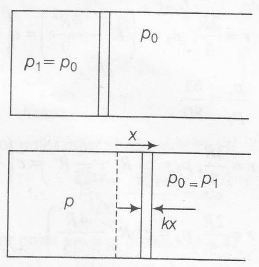Answer:
Option A,B,C
Explanation:
Note: This question can be solved if the right-hand side chamber is assumed to open so that its pressure remains constant even if the piston shifts towards night.

(a) $pV=n RT \Rightarrow p \propto\frac{T}{V}$
Temperature is made three times and volume is doubled
$\Rightarrow$ $p_{2}=\frac{3}{2}p_{1}$
Further $x=\frac{\triangle V}{A}=\frac{V_{2}-V_{1}}{A}$
$=\frac{2V_{1}-V_{1}}{A}=\frac{V_{1}}{A}$
$p_{2}=\frac{3p_{1}}{2}=p_{1}+\frac{kx}{A}$
$\Rightarrow$ $KX=\frac{P_{1}A}{2}$
Energy of spring
$\frac{1}{2}kx^{2}=\frac{p_{1}A}{4}x=\frac{p_{1}V_{1}}{4}$
(b) $\triangle U=nc_{v}\triangle T=n\left( \frac{3}{2}R\right) \triangle T$
= $\frac{3}{2}(p_{2}V_{2}-p_{1}V_{1})$
$\frac{3}{2}\left[ \left(\frac{3}{2}P_{1}\right) (2V_{1})-p_{1}V_{1}\right]=3p_{1}V_{1}$
(c) $p_{2}=\frac{4p_{1}}{3}\Rightarrow p_{2}=\frac{4}{3}p_{1}=p_{1}+\frac{kx}{A}$
$\Rightarrow$ $kx=\frac{p_{1}A}{3}\Rightarrow x=\frac{\triangle V}{A}=\frac{2V_{1}}{A}$
$W_{gas}=(p_{0}\triangle V +W_{spring})$
$=(p_{1}Ax+\frac{1}{2}kx.x)$
$=+\left( p_{1}A.\frac{2V_{1}}{A}+\frac{1}{2}.\frac{p_{1}A}{3}.\frac{2V_{1}}{A}\right)$
$=2p_{1}V_{1}+\frac{p_{1}V_{1}}{3}=\frac{7p_{1}V_{1}}{3}$
(d)
$\triangle Q=W+\triangle U$
= $\frac{7p_{1}V_{1}}{3}+\frac{3}{2}\left( p_{2}V_{2}-p_{1}V_{1}\right)$
= $\frac{7p_{1}V_{1}}{3}+\frac{3}{2}\left(\frac{4}{3}p_{1}.3V_{1}-p_{1}V_{1} \right)$
= $\frac{7p_{1}V_{1}}{3}+\frac{9}{2}p_{1}V_{1} =\frac{41p_{1}V_{1}}{6}$
Note: $\triangle U=\frac{3}{2}(p_{2}V_{2}-p_{1}V_{1})$ , has been obtained in part (b).